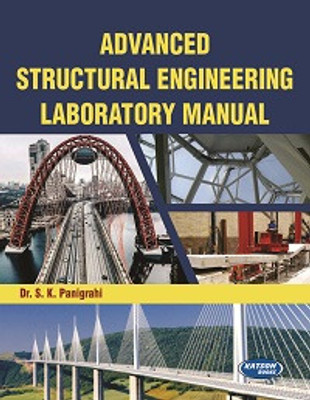Advanced Structural Engineering Laboratory Manual(Paperback, Dr. S.K. Panigrahi)
Quick Overview
Product Price Comparison
CONTENTSPart 1 Concrete LaboratoryA: Characterization of Cement ŌĆó Standard consistency and Setting times test of cement ŌĆó Fineness test of Cement by Sieve analysis ŌĆó Soundness test of cement ŌĆó Specific gravity test of cement ŌĆó Compressive strength test of cement.B: Characterization of Aggregate ŌĆó Particle size distribution of fine and coarse aggregates ŌĆó Specific gravity and Water absorption test of fine aggregates ŌĆó Specific gravity and Water absorption test of coarse aggregates ŌĆó Unit weight and Void test of fine and coarse aggregates ŌĆó Aggregate Crushing value test of coarse aggregate ŌĆó Aggregate Impact value test of coarse aggregate ŌĆó Aggregate Abrasion value of coarse aggregate ŌĆó Flakiness index and Elongation index test of coarse aggregate ŌĆó Bulking test of fine aggregates ŌĆó Shape and Dimension test for brickC: Characterization of Brick ŌĆó Water absorption test of brick ŌĆó Compressive strength test of BrickD: Characterization of Concrete ŌĆó Slump test and Compaction factor test of wet concrete ŌĆó Stress-strain curve, modulus of elasticity, and Poisson's ratio test of concrete ŌĆó Flexural strength/Modulus of Rupture test of concrete ŌĆó Split tensile strength test of concreteE: Characterization of Self-Compacting Concrete (SCC) ŌĆó Slump Flow Test of SSC ŌĆó T50 CM Slump Flow Test of SSC ŌĆó V Funnel Test of SSC ŌĆó V Funnel at T5 Minutes of SSC ŌĆó L Box Test of SSC ŌĆó J Ring Test of SSC.Part 2 Study of Durability Properties for ConcreteŌĆó Water Absorption test of concrete ŌĆó Sorptivity test of concrete ŌĆó Rapid Chloride Permeability test of concrete (RCPT) ŌĆó Acid Resistance test of concrete ŌĆó Sulphate Resistance test of concrete ŌĆó Chloride Resistance test of concretePart 3 Study of Microstructural PropertiesŌĆó Scanning Electron Microscope (SEM) test ŌĆó Energy Dispersive X-Ray Spectroscopy (EDX) test ŌĆó X-Ray Diffraction (XRD) test ŌĆó Fourier Transform Infrared Spectroscopy (FTIR) test ŌĆó Thermogravimetric Analysis (TGA) testPart 4 Structural Engineering LaboratoryA: Characterization of Steel ŌĆó To determine the unit mass (kg/m) and the effective cross-sectional area of the given HYSD bar ŌĆó To check the transverse cracks in the bent position after bend and rebend test of HYSD bars ŌĆó Determination of ultimate tensile strength by UTM and percentage elongation of given HYSD bar ŌĆó To determine the ultimate tensile strength, yield strength, and percentage elongation of a mild steel couponB: Non Destructive Testing ŌĆó To determine the quality of concrete using non-destructive testing of concrete by Ultrasonic Pulse Velocity method ŌĆó To assess the available compressive strength in concrete using non-destructive testing by the Rebound Hammer methodC: Mix Design of Concrete ŌĆó To perform the M25 concrete mix design following IS 10262:2019 ŌĆó To test an RCC beam under two-point load under flexureD: Some Regular Structural Analysis Problems ŌĆó (a) To compare the experimental and theoretical values of the horizontal thrust of a three-hinged parabolic arch. ŌĆó To plot the Influence Line Diagram of the horizontal thrust of the three-hinged arch ŌĆó (a) To draw the profile of the two hinged arch (b) To compare the horizontal thrust for a given system of loading at the roller end both experimentally and analytically in a two-hinged arch. ŌĆó To verify Maxwell theorem of reciprocal deflection by needle beam apparatus and to measure flexural rigidityPart 5 Corrosion Estimation of steel in ConcreteŌĆó To determine the mass loss of steel reinforcement embedded in concrete due to corrosion by Impressed Current Technique (ICD) through accelerated corrosion process. ŌĆó To estimate the electrical half-cell potential of uncoated reinforcing steel in concrete, so that the corrosion activity of the reinforcing steel can be determined.


